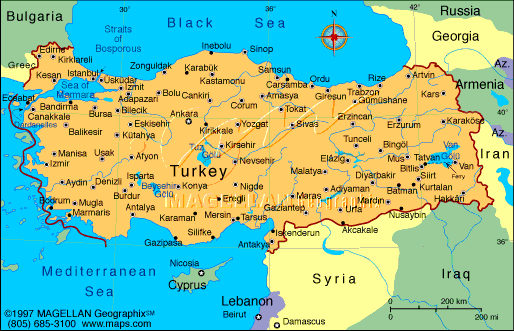I had been looking forward to this trip for years and when a fam trip came up I jumped at the opportunity. I was not disappointed.
It was an 11 days trip, which is not nearly enough for such a large country but perfect to give you the desire to come back and see more.
I must say right now that we only saw a small part of Turkey. It is a huge country: Its territory stretches for 1700 km from east to west and 600 km from the shores of the Black sea to the Mediterranean coast. It covers 800 000 square kilometers. It is a country that straddles 2 continents: Asia and Europe, it sits on both sides of the Bosphorous, of the Marmara sea and the Dardanelles. It shares borders with Greece, Bulgaria, Georgia, Armenia, Iran, Irak and Syria.
The relief is extremely varied: high plateaus crossed by many rivers (among which the Tigre and the Euphrate) and dotted with lakes some of which are as large as an inside sea. Two mountain chains (Pontique chain and Taurus chain) frame rich coastal plains. Along the four seas that border Turkey stretch more than 8333 km of coastline.
Turkey rests over the junction of three tectonic plaques: the European, the African and the Euroasian, which makes it very susceptible to earthquakes.
The climate is Mediterranean, winters are temperate but rainy (colder and snowier in the mountains), summers are hot (torrid in the south) and dry.
Apart from the geography, and geology that provide astounding landscapes the country is fascinating because of its history and what the various civilizations have left behind. There are traces of paleolithic men dating back 8000BC in the Antalya region! It is a long and complicated story as this has always been a strategic area coveted by all. Here are a few highlights to help place the different sites that I visited:
6500 to 5300 BC. Catahöyük, the first known city is founded.
1900 BC the Hittites settle there and their capital is: Hattusha (Bogazkoy)
Already in 1250 BC this region was coveted and the Greeks attacked Troy.
In 330 BC, this region, as well as the entire middle east, is conquered by Alexander the Great.
Between the years 312 and 130 BC large cities such as Ephesus appear, then the Roman Empire starts to take shape.
In 196 AD Septime Severe conquers Byzance, but in 293, the Roman Empire is split and Bizance becomes capital of the Oriental Roman Empire.
In 330, the emperor Constantine founds the “New Rome” in Constantinople.
Two centuries later, Justinien orders the building of Aya Sofia, the largest religious building in the world.
In 364 Byzantine defeat at the hands of the Arabs.
669-678, Mohamet’s armies conquer what is now Turkey.The crusades starts around 1096 and Constantinople is taken in 1204.
In 1453, Mehmet II accedes to the throne and conquers Constantinople, it is the start of the Ottoman rule and the end of the Middle Ages.
Under Suleyman the Magnificient (1520 – 1566) their empire will spread over the Middle-East, North Africa and, in Europe, up to Vienna’s doorstep.
The fall of the Ottoman empire starts in 1571 with the defeat of the Turkish fleet in Lepanto and it dies out completely around 1876.
The Balkan war (1912 – 1913) and the first world war completed the destruction of the Empire.
The Turkish Republic is proclaimed by Mustapha Kemal in 1923, ending the Ottoman rule. The Lausanne treaty recognizes today’s Turkish frontiers. Mustapha Kemal, who takes on the name “Atatürk” ( father of all Turks) starts the modernization of his country: the Islamic law is abolished in favor of the civil code. The state becomes secular, Islam is no longer the
state religion, polygamy and religious brotherhoods are forbidden. Women get the right to vote. Atatürk dies in 1938.
Turkey remains neutral during the second world war.
In 1951, Turkey joins Nato.
In 1980, the army takes over, ending the stalemate between the pro-soviet left and the pro-islam right. The military dictatorship remains in power until the 1983 elections which were won by the right-center party of Turgut Ozal.
In 1993, upon the death of Turgut Ozal, parliamentary democracy is well established in Turkey and the Islamic party is forbidden .
Now that we are done with the theory, lets start the TRIP!!!!
The chapters are in chronological order, simply click the link at the end of each chapter or click directly on a link below:
1 – Istanbul
2 – Bursa
3 – Ephesus
4 – Pamukkale
5 – Aphrodisias
6 – Perge
7 – Aspendos
8 – Mevlana Museum
9 – Caravanserai
10 – Cappadoce
11 – Ankara
12 – Conclusion
